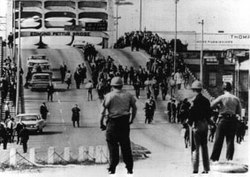Selma to Montgomery marches
The marches from Selma to Montgomery, led President Lyndon B. Johnson to sign the Voting Rights Act of 1965. The first March occurred on March 7, 1965 and became known as Bloody Sunday. Between 500-600 civil rights protesters began the march on March 7 but were stopped by Sheriff Jim Clark. The Sheriff of Dallas County (where Selma is located) ordered that all white men over the age of 21 should report to the court house steps where he made them deputies and equipped them to counter the protesters. They were joined by state troopers and beat protesters so severely that 17 were hospitalized. They beat the protesters with batons, fired tear gas into the crowd, and charged them from horseback.
Amelia Boynton, who had helped organize the march as well as marching in it, was beaten unconscious. A photograph of her lying on the road of the Edmund Pettus Bridge appeared on the front page of newspapers and news magazines around the world. [1] 17 marchers were hospitalized and 50 treated for lesser injuries.
The executive board of the NAACP unanimously passed a resolution the day after "Bloody Sunday", warning,
If Federal troops are not made available to protect the rights of Negroes, then the American people are faced with terrible alternatives. Like the citizens of Nazi-occupied France, Negroes must either submit to the heels of their oppressors or they must organize underground to protect themselves from the oppression of Governor Wallace and his storm troopers.[2]
After the events were televised, President Johnson issued an order mobilizing the Alabama National Guard to protect the marchers on their 54 mile (87 km) journey from Selma to Montgomery, Alabama. This second march would start on March 21, 1965 and end on March 25, 1965 at the steps of the state capitol in Montgomery, Alabama. Before the second march even began President Johnson went to congress to ask them for a bill that would guarantee voting rights for all citizens and end discrimination at polling places (such as poll taxes and literacy tests).
Selma To Montgomery Marches Media
James Bevel, SCLC's director of direct action and nonviolent education, initiated and organized the first march.
President Barack Obama's speech marking the 50th anniversary of the Selma to Montgomery marches
References
- ↑ "The wire photo of her left for dead on Edmund Pettus Bridge, which went around the world on the news that night, helped spark the outpouring of support for the civil rights movement...", Schiller Institute. Archived July 21, 2018, at the Wayback Machine
- ↑ "Selma Outrage Condemned", The Crisis, Vol. 72, No. 4, April 1965.





